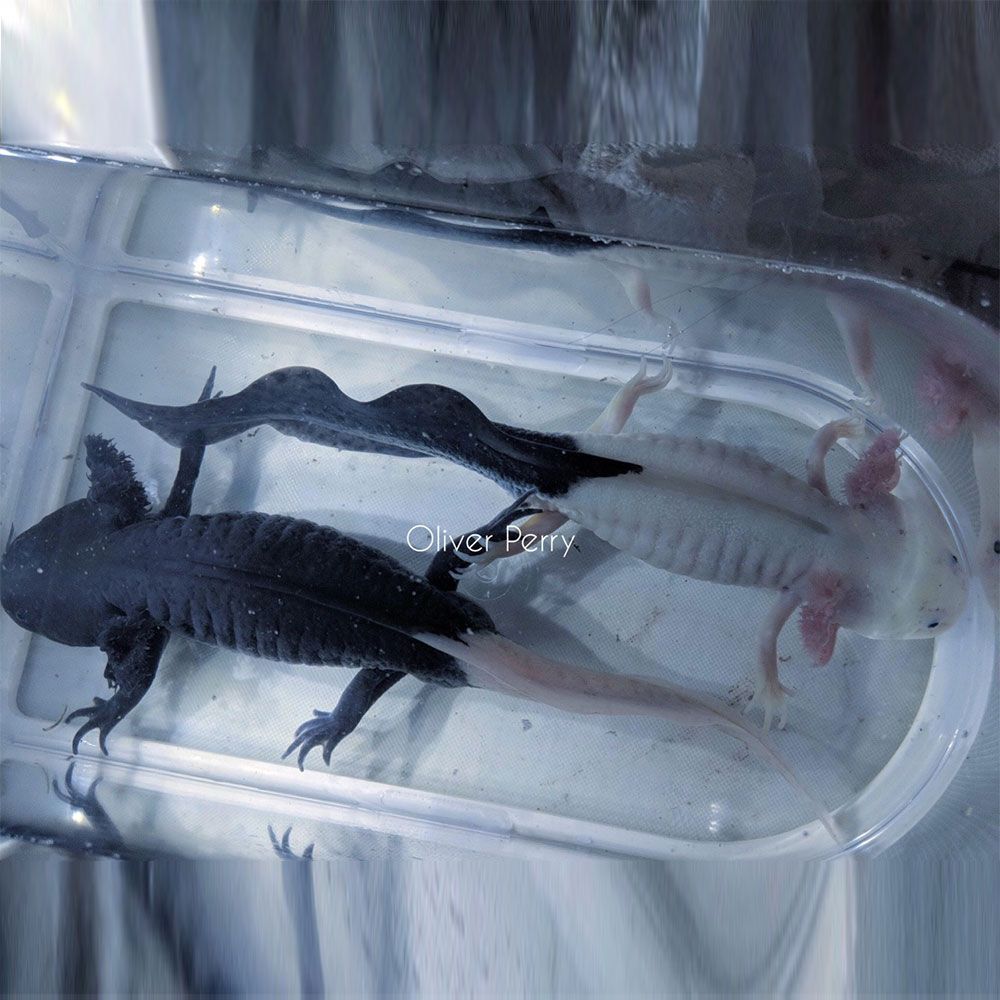Featured Image by Oliver Perry
Do you fancy keeping a rare and exotic axolotl as a pet? Well, then you should definitely learn about firefly axolotl.
The lab-bred axolotl is not only rare but also has a bit of controversy surrounding it. But that doesn’t take away its charm one bit.
It is a fun companion and can be cared for like any regular axolotl.
Note: If you plan to bring this cute buddy home, definitely check out our comprehensive axolotl care guide.
What is a Firefly Axolotl?
A firefly axolotl is a unique morph created through artificial means. It involves swapping the tail sections of two individuals (aka skin grafting) during embryonic development.
Developed in a laboratory, this axolotl has a dark body and a light-colored tail that glows gently under blue or black lighting due to the Green Fluorescent Protein (GFP) albino tail, which led to its name.
This rare and expensive axolotl variation was initially bred for research on the distribution of melanocytes in axolotls, particularly in mosaic axolotls.
What is the History of Firefly Axolotl?
Firefly axolotls were first created by scientist Lloyd Strohl II. Hence, they were also called Strohl’s Herptiles. These axolotls are a result of merging embryos, not by cutting and attaching tails, as the myth suggests.
This fusion occurs painlessly during the embryonic stage, ensuring the axolotls don’t feel discomfort. The controversy lies in their artificial creation through scientific experimentation.
What are the Concerns in keeping a Firefly Axolotl?
Regrettably, despite Lloyd Strohl II ceasing production of fireflies after his research, the demand for these unique axolotls has continued.
This created a market niche for others who have discovered alternative methods to breed them.
However, the practices of creating firefly axolotls in the current times have raised ethical concerns.
Strohl conducted the experiments in a painless way before they’ve even hatched. But these new producers are experimenting on young axolotls, i.e., after they’ve hatched.
They are subjected to surgeries using anesthesia to produce fireflies. However, they are given no pain relief after the surgery. This leads to deformities, and, in some cases, the second axolotl is discarded after the tail is taken.
Furthermore, these surgeries are solely for cosmetic purposes – and not for research.
How does Firefly Axolotl look?
Firefly axolotls are primarily dark-colored wild-type axolotls with a glowing green fluorescent protein albino tail, resembling the luminescence of fireflies.
Of course, they still have basic axolotl traits like a smiling face, broad head, eel-like body, small legs, and fin-like external gills.
However, nowadays, sellers/creators are experimenting further. So, you may also find this different colored GFP patch on the abdomen, face, and even eyes. There are high chances of these invasive operations leading to defects like blindness and disfigurement.
Some are even butchering these to create checkerboard, dinosaur, and candy corn patterns.
What is the Cost of Firefly Axolotl?
The cost of bringing a firefly axolotl home requires an initial investment, usually from $30 to $300.
Prices depend on factors like color, size, and breeder reputation. Despite variations, these unique creatures are reasonably priced for dedicated enthusiasts.
How to Buy a Firefly Axolotl?
Owing to ethical production issues, many suggest not buying these axolotls at all. This way, you can do your part in stopping animal cruelty and discourage unethical practices.
But needless to say, so long as there’s a demand, unethical practices will continue.
However, choosing a reputable breeder is essential if you’re eager to get one. This ensures you get a healthy specimen that didn’t undergo unnecessary pain or doesn’t have defects.
Some may charge a premium amount due to their focus on the axolotls’ health and genetics compared to less scrupulous sources.
A word from FishInAquarium
In conclusion, firefly axolotls are not just visually stunning additions to your aquarium; they also bring a touch of rarity and uniqueness to your aquatic collection.
However, their scarcity and endangered status emphasize the need for responsible and attentive care.
Handling them with utmost care and providing a secure environment to prevent any mishaps is essential.
Regular observation is vital; if you notice any irregularities, prompt attention and, if necessary, professional veterinary care are crucial to ensure their well-being.
If you found this information helpful, please share it with fellow axolotl enthusiasts. For any further support, feel free to reach out via email, and we’ll get things sorted!


